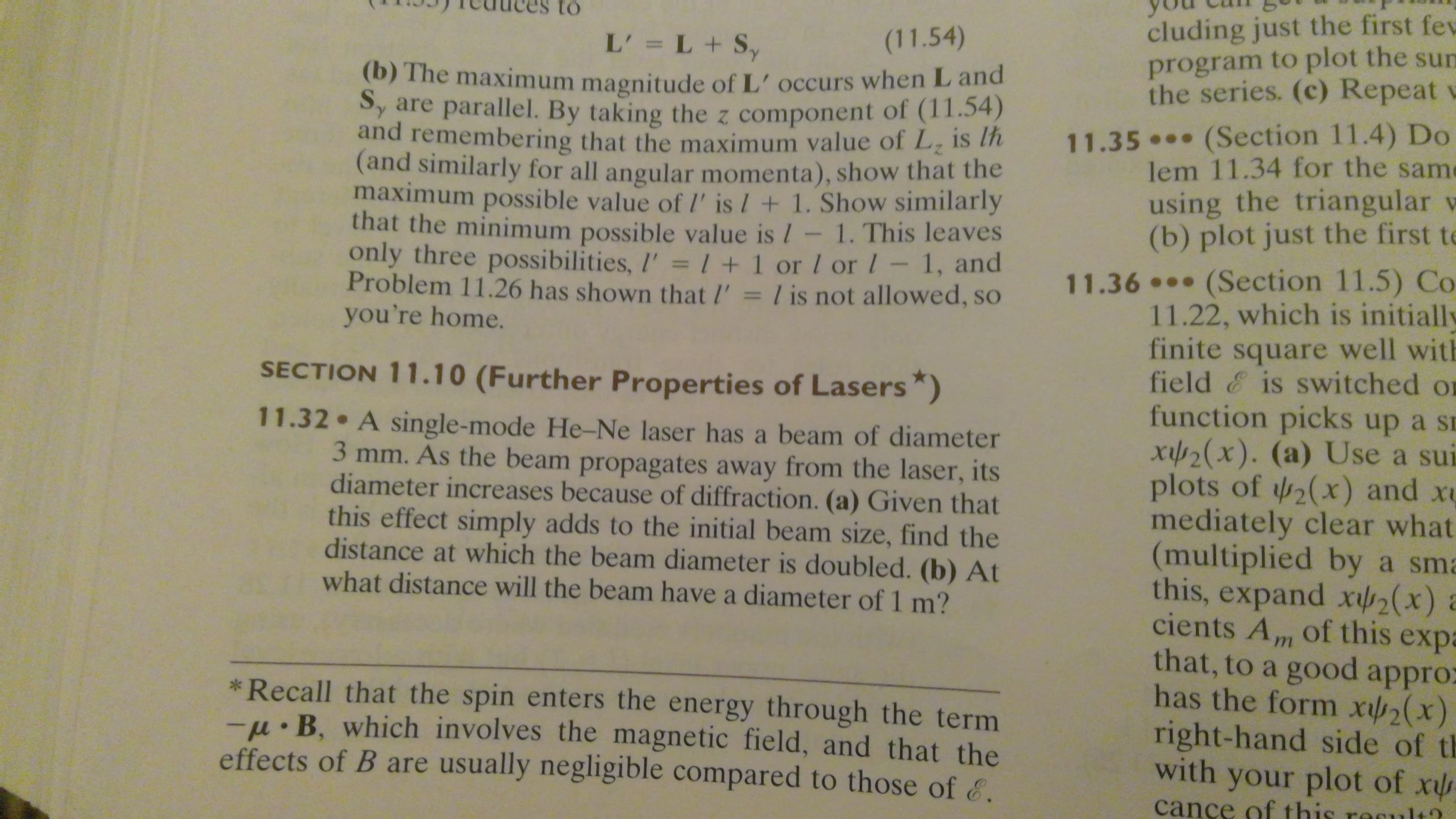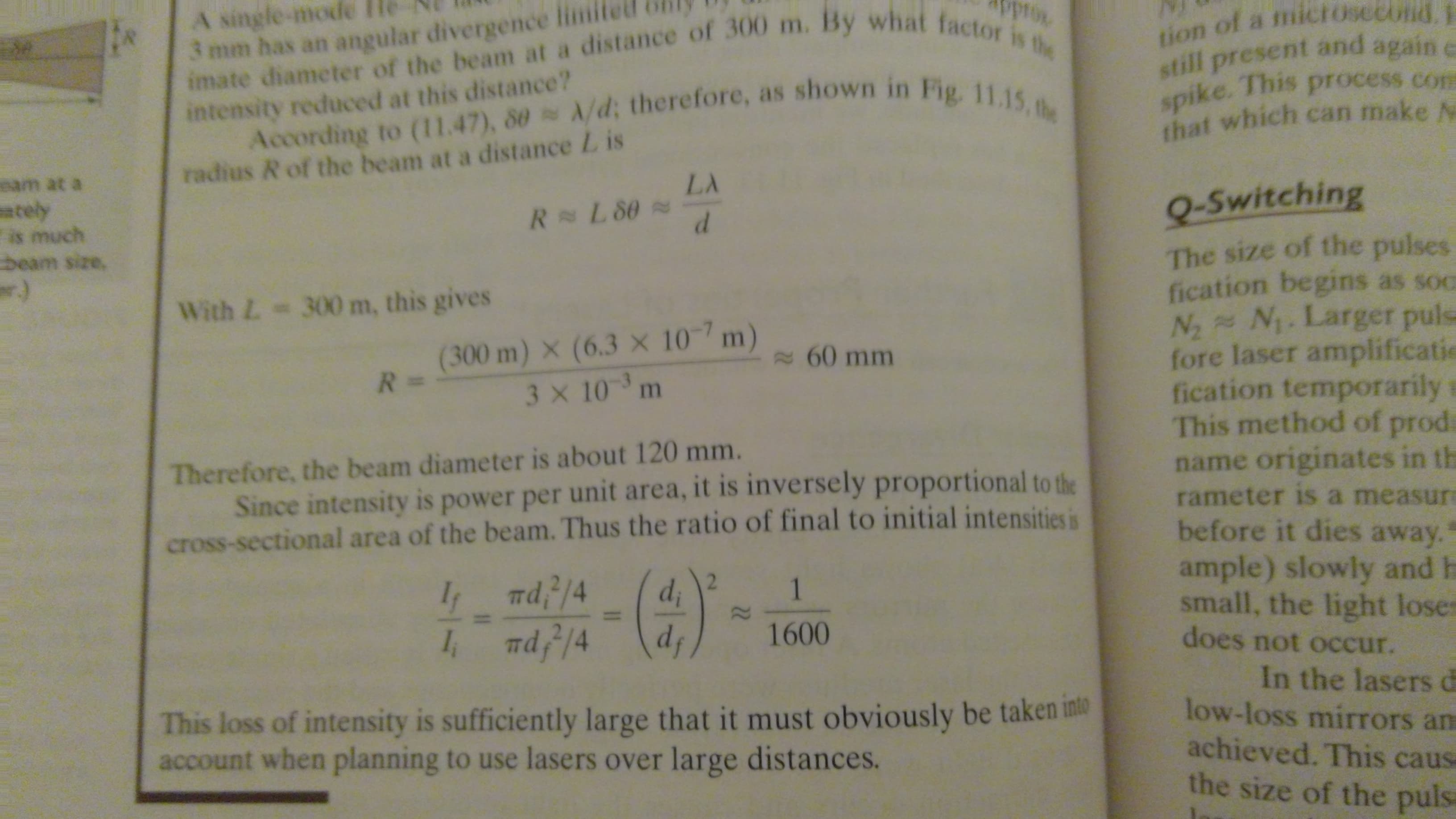to cluding just the first few program to plot the sum the series. (c) Repeat v L'= L+S, (11.54) (b) The maximum magnitude of L' occurs when L and Sy are parallel. By taking the z component of (11.54) and remembering that the maximum value of L is lh (and similarly for all angular momenta), show that the maximum possible value of I' is I + 1. Show similarly that the minimum possible value is l- 1. This leaves only three possibilities, I' = +1 or l or l– 1, and Problem 11.26 has shown that l' = l is not allowed, so you're home. 11.35 (Section 11.4) Do lem 11.34 for the sam using the triangular v (b) plot just the first te ... 11.36 (Section 11.5) Co 11.22, which is initially finite square well with field & is switched or function picks up a sr x42(x). (a) Use a sui plots of 2(x) and xu mediately clear what (multiplied by a sma this, expand x2(x) a cients Am of this expa that, to a good appro: has the form x2(x) right-hand side of th with your plot of x %3D SECTION 11.10 (Further Properties of Lasers*) 11.32 A single-mode He-Ne laser has a beam of diameter 3 mm. As the beam propagates away from the laser, its diameter increases because of diffraction. (a) Given that this effect simply adds to the initial beam size, find the distance at which the beam diameter is doubled. (b) At what distance will the beam have a diameter of 1 m? * Recall that the spin enters the energy through the term -u B, which involves the magnetic field, and that the effects of B are usually negligible compared to those of &. cance of this result? A single-mode 3 mm has an angular divergence lim prot imate diameter of the beam at a distance of 300 m. By what factor is the According to (11.47), 80 A/d; therefore, as shown in Fig. 11.15, the tion of a mict0second. still present and again e spike. This process com that which can make N intensity reduced at this distance? radius R of the beam at a distance L is eam at a LA ately Q-Switching The size of the pulses fication begins as soc N N. Larger pulsa fore laser amplificatie fication temporarily This method of prod name originates in th R L 80 beam size. r) With L 300 m, this gives (300 m) x (6.3 x 10-7 m) R 3= 3 x 10 m 60 mm Therefore, the beam diameter is about 120 mm. Since intensity is power per unit area, it is inversely proportional to the cross-sectional area of the beam. Thus the ratio of final to initial intensities is rameter is a measur before it dies away." ample) slowly and h small, the light loses does not occur. (4) 2. I1 md/4 d 1 22 1600 In the lasers di low-loss mirrors am achieved. This caus the size of the puls This loss of intensity is sufficiently large that it must obviously be taken into account when planning to use lasers over large distances.
to cluding just the first few program to plot the sum the series. (c) Repeat v L'= L+S, (11.54) (b) The maximum magnitude of L' occurs when L and Sy are parallel. By taking the z component of (11.54) and remembering that the maximum value of L is lh (and similarly for all angular momenta), show that the maximum possible value of I' is I + 1. Show similarly that the minimum possible value is l- 1. This leaves only three possibilities, I' = +1 or l or l– 1, and Problem 11.26 has shown that l' = l is not allowed, so you're home. 11.35 (Section 11.4) Do lem 11.34 for the sam using the triangular v (b) plot just the first te ... 11.36 (Section 11.5) Co 11.22, which is initially finite square well with field & is switched or function picks up a sr x42(x). (a) Use a sui plots of 2(x) and xu mediately clear what (multiplied by a sma this, expand x2(x) a cients Am of this expa that, to a good appro: has the form x2(x) right-hand side of th with your plot of x %3D SECTION 11.10 (Further Properties of Lasers*) 11.32 A single-mode He-Ne laser has a beam of diameter 3 mm. As the beam propagates away from the laser, its diameter increases because of diffraction. (a) Given that this effect simply adds to the initial beam size, find the distance at which the beam diameter is doubled. (b) At what distance will the beam have a diameter of 1 m? * Recall that the spin enters the energy through the term -u B, which involves the magnetic field, and that the effects of B are usually negligible compared to those of &. cance of this result? A single-mode 3 mm has an angular divergence lim prot imate diameter of the beam at a distance of 300 m. By what factor is the According to (11.47), 80 A/d; therefore, as shown in Fig. 11.15, the tion of a mict0second. still present and again e spike. This process com that which can make N intensity reduced at this distance? radius R of the beam at a distance L is eam at a LA ately Q-Switching The size of the pulses fication begins as soc N N. Larger pulsa fore laser amplificatie fication temporarily This method of prod name originates in th R L 80 beam size. r) With L 300 m, this gives (300 m) x (6.3 x 10-7 m) R 3= 3 x 10 m 60 mm Therefore, the beam diameter is about 120 mm. Since intensity is power per unit area, it is inversely proportional to the cross-sectional area of the beam. Thus the ratio of final to initial intensities is rameter is a measur before it dies away." ample) slowly and h small, the light loses does not occur. (4) 2. I1 md/4 d 1 22 1600 In the lasers di low-loss mirrors am achieved. This caus the size of the puls This loss of intensity is sufficiently large that it must obviously be taken into account when planning to use lasers over large distances.
Related questions
Question
How do I solve for Problem 11.32? This problem is in a chapter titled, "Atomic Transitions and Radiation." This is under

Transcribed Image Text:to
cluding just the first few
program to plot the sum
the series. (c) Repeat v
L'= L+S,
(11.54)
(b) The maximum magnitude of L' occurs when L and
Sy are parallel. By taking the z component of (11.54)
and remembering that the maximum value of L is lh
(and similarly for all angular momenta), show that the
maximum possible value of I' is I + 1. Show similarly
that the minimum possible value is l- 1. This leaves
only three possibilities, I' = +1 or l or l– 1, and
Problem 11.26 has shown that l' = l is not allowed, so
you're home.
11.35 (Section 11.4) Do
lem 11.34 for the sam
using the triangular v
(b) plot just the first te
...
11.36 (Section 11.5) Co
11.22, which is initially
finite square well with
field & is switched or
function picks up a sr
x42(x). (a) Use a sui
plots of 2(x) and xu
mediately clear what
(multiplied by a sma
this, expand x2(x) a
cients Am of this expa
that, to a good appro:
has the form x2(x)
right-hand side of th
with your plot of x
%3D
SECTION 11.10 (Further Properties of Lasers*)
11.32 A single-mode He-Ne laser has a beam of diameter
3 mm. As the beam propagates away from the laser, its
diameter increases because of diffraction. (a) Given that
this effect simply adds to the initial beam size, find the
distance at which the beam diameter is doubled. (b) At
what distance will the beam have a diameter of 1 m?
* Recall that the spin enters the energy through the term
-u B, which involves the magnetic field, and that the
effects of B are usually negligible compared to those of &.
cance of this result?

Transcribed Image Text:A single-mode
3 mm has an angular divergence lim
prot
imate diameter of the beam at a distance of 300 m. By what factor is the
According to (11.47), 80 A/d; therefore, as shown in Fig. 11.15, the
tion of a mict0second.
still present and again e
spike. This process com
that which can make N
intensity reduced at this distance?
radius R of the beam at a distance L is
eam at a
LA
ately
Q-Switching
The size of the pulses
fication begins as soc
N N. Larger pulsa
fore laser amplificatie
fication temporarily
This method of prod
name originates in th
R L 80
beam size.
r)
With L 300 m, this gives
(300 m) x (6.3 x 10-7 m)
R 3=
3 x 10 m
60 mm
Therefore, the beam diameter is about 120 mm.
Since intensity is power per unit area, it is inversely proportional to the
cross-sectional area of the beam. Thus the ratio of final to initial intensities is
rameter is a measur
before it dies away."
ample) slowly and h
small, the light loses
does not occur.
(4)
2.
I1 md/4
d
1
22
1600
In the lasers di
low-loss mirrors am
achieved. This caus
the size of the puls
This loss of intensity is sufficiently large that it must obviously be taken into
account when planning to use lasers over large distances.
Expert Solution
This question has been solved!
Explore an expertly crafted, step-by-step solution for a thorough understanding of key concepts.
This is a popular solution!
Trending now
This is a popular solution!
Step by step
Solved in 2 steps with 2 images
